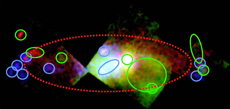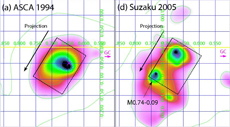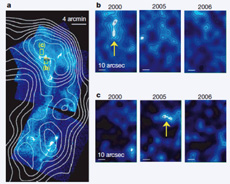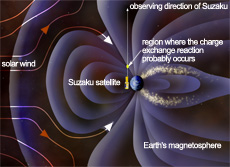


X-ray map of the central region of the Milky Way. This map shows a region along the galactic plane with an area of 500 light-years by 100 light-years. The galactic center exists in the white portion near the center of the image, and the red-dotted line is the high-temperature plasma sphere. The green ellipsoid is a supernova remnant, and the blue circle is the molecular cloud. The black regions have not yet been observed.

Molecular cloud of Sagittarius B, observed by ASCA in 1994 (left) and by Suzaku in 2005 (right).
At the center of the Milky Way, the galaxy that’s home to our planet, there is a black hole that is a few million times the mass of the Sun and is currently considered to be in a dormant state. Also, stars are being formed near the center of the galaxy, and these activities are observed by electromagnetic waves of various wavelengths, such as radio waves, X-rays and gamma rays. Suzaku confirmed from the precise observations of X-ray spectra emitted from the highly-ionized ions of heavy elements such as iron that the X-ray emission from a spherical region with a radius of about 500 light-years is coming from plasma with a temperature of 70 million degrees. This suggests that even today stars formed by active star formation cause a lot of supernova explosions and emit a large amount of heavy elements into space. In the center of the Milky Way, there are still many undiscovered supernova remnants, and it’s possible that the supernova explosions that created these remnants were the energy sources of the high-temperature plasma.
Suzaku has also observed a neutral iron emission line from the central region of the galaxy, and one from a molecular cloud 300 light-years away from the galactic center. A molecular cloud is an aggregation of gases and cosmic-dust particles, and because its temperature is low, normally the iron atoms it contains do not emit X-rays. However, when the molecular cloud is irradiated from the outside with strong X-rays, it emits characteristic X-rays of is own. Suzaku’s X-ray image of the molecular cloud called Sagittarius-B appears different from the image obtained by the X-ray astronomy satellite ASCA about ten years ago. If we suppose that the strong X-rays irradiating the molecular cloud come from the black hole at the center of the galaxy, it is possible that the wave front of the X-ray flare passed very close to this molecular cloud. In other words, the black hole at the center of the Milky Way was active just 300 years ago.

Cosmic rays are high-energy charged particles, mainly protons, that fly around in space at nearly the speed of light, and bombard the Earth at every moment. Ever since cosmic rays were discovered at the beginning of the twentieth century, scientists have wondered from where they come how they are accelerated. Suzaku’s observations have given us some important clues. One was obtained through the observation of supernova remnant RX J1713-3946, together with the observation with the NASA's Chandra X-ray Observatory. This celestial body emits not only X-rays but also ultrahigh-energy gamma rays, and it’s the gamma rays that attracted our attention.
First, the Chandra X-ray observatory, which has exceptional spatial resolution, captured X-rays whose intensity varied among 2000, 2005 and 2006 observations, namely on time scale of just one year, which is a very short time in astrophysics. , This corresponds to seeing the behavior of charged particles when they are gaining energy (accelerating) and losing energy (cooling). This was the first time we had captured the acceleration phenomena of the cosmic rays directly. On the other hand, Suzaku measured X-ray spectra up 40 keV (kilo electron volt), revealing that X-ray intensities rapidly decrease from near 10 keV. The fact that the X-ray spectra extend up to such a high energy shows that electrons are also accelerated effectively. By combining the observation results of two satellites, it becomes clear that cosmic rays consisting primarily of protons are created and accelerated by means of the shock wave of the supernova remnant.

An X-ray image of supernova remnant RX J1713-3946 observed by Chandra. There are regions whose X-ray intensity varies on time scale of about a year. (reproduced from Uchiyama et al., Nature 2007)


X-rays generated near the Earth. X-rays are emitted through the charge exchange reaction between the ionized ions in the solar wind and the neutral matter. (the background picture by: NASA, CXC, M. Weiss)
Suzaku detected that increase of X-ray intensity during the observation of background radiation, and obtained a firm evidence that its origin is the solar wind. We studied how the X-ray spectrum changes when the intensity of the radiation increases. Suzaku’s observations detected a characteristic X-ray that is emitted by the interaction of highly ionized ions and neutral matter by means of charge exchange when the X-ray intensity is increased. In the charge exchange reaction an electron moves from the neutral matter to the ionized ions, leaving the ions in exited states. Exited ions emits X-ray line emissions characteristics of the reaction. Suzaku found that the emission comes from an altitude of about 6000 km from Earth surface. We consider that the completely ionized carbon ions and highly ionized oxygen ions in the solar wind penetrate from the magnetic pole of the Earth into a 6000-km altitude, and emit X-rays by the charge exchange reaction with the hydrogen atoms existing there.
This reaction occurs not only in near-Earth regions and near comets, but also in other places in the solar system. For example, in the aurora of Jupiter, the X-rays generated by the charge exchange of ionized ions in the solar wind are observed. Suzaku also observes Jupiter and other planets, and studies in detail what kinds of X-rays are emitted from Jupiter.